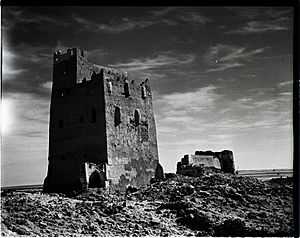Attack on Dammam facts for kids
Quick facts for kids Attack on Dammam |
|||||||
|---|---|---|---|---|---|---|---|
 Fort of Dammam |
|||||||
|
|||||||
| Belligerents | |||||||
| Commanders and leaders | |||||||
| Unknown | |||||||
| Strength | |||||||
| 1 ship | Unknown | ||||||
| Casualties and losses | |||||||
| 3 killed 5 wounded |
Unknown | ||||||
The Attack on Dammam was a military event in 1866. A British ship tried to destroy a fort in Dammam, which was controlled by the Saudis. However, the attack did not succeed.
Why the Attack Happened
In late 1865, the Saudis moved into an area called Oman. Oman was a friend of the British at that time. During this time, a British Indian person died while trying to escape, and ten other Indian people had their belongings stolen.
This made the British very upset. They sent a strong message, called an ultimatum, to the Saudi leader, Abdullah bin Faisal. The British demanded:
- An apology for the deaths of the British Indian and the other Indians.
- Payment of 27,000 dollars as a penalty.
- A promise that no similar attacks would happen again.
The British warned that if they did not get a reply in 17 days, they would attack Saudi forts along the coast. The British ship H.M.S. Highflyer waited for a response. When no answer came, the British decided to attack.
The Attack on Dammam
On February 2, the H.M.S. Highflyer sailed to attack Saudi forts in Qatif and Dammam. First, at Qatif, the British ship entered the harbor. They destroyed a small fort there called Burj abul Lif and also a small boat.
The next day, the ship arrived in Dammam. Lieutenant Long led a group of British soldiers from the ship. They had to walk through water to reach the fort. They tried to attack the fort, hoping to break inside. However, the fort's defenders were much stronger than the British expected. The British soldiers could not get in. They were forced to retreat. In this attempt, three British soldiers were killed, and five were injured.
On February 4, the British tried again. The water level had risen, which helped them. The ship fired cannons, shells, and rockets at the fort. But even with all the firing, the fort's walls were too strong. They could not be broken. The fort stayed under Saudi control.
The attack failed because the British did not know enough about the local area. They only had one local person helping them.
What Happened Next
When the H.M.S. Highflyer returned to Muscat on February 9, Captain Lewis Pelly heard about the defeat at Dammam. He wanted to show that Britain was still powerful. So, he decided to punish the Janabah tribe in Sur, who had also refused to pay money to the British.

